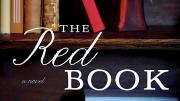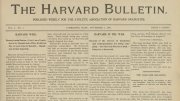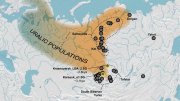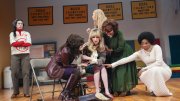Reading The Red Book, an often funny and entertaining Harvard-inspired confection, is a bit like watching the women of Sex and The City return for their twentieth college reunion. Except we don’t get to see their splashy designer outfits. The new novel by Deborah Copaken Kogan ’88 chronicles the midlife stories of four fictitious friends from the class of 1989 as problems in their messy lives of privilege come to a head during a long weekend in Cambridge. (The title comes from the nickname for the anniversary books put out by the Class Report Office—part of the Harvard Alumni Association [HAA]—every five years, in conjunction with class reunions.)
One unhappily married character, a dabbling artist questioning her sexual identity, is arrested for a mountain of unpaid parking tickets from her undergraduate years. A Vietnamese adoptee and international journalist mourns the death of her mother, while grappling with a partner’s infidelity. A third roommate tends perfectly to four children in place of her once-promising acting career. And their biracial friend, raised in a hippie commune in California, hopes to solve her infertility problems with the unwitting aid of her once Adonis-like freshman-year boyfriend (whose WASP parents rejected her so long ago). Oh, and she was also recently laid off from Lehman Brothers.
In the words of one reader: “It’s trash, but it’s good trash.” No source of melodrama is left unexamined. And all reflect the novel’s primary theme, veiled in sometimes frenetically paced humor: coping with loss, failure, and disappointment while confronting the exuberant ghosts of the characters’ youthful selves at Harvard. “The impetus to write the book came out of the vortex of loss and insanity in my own life,” says Kogan, a writer, photographer, and married mother of three in New York City. “I was envisioning what dreams you have to let go of, all the compromises you have to make.” In short: life as it once was expected to be has morphed into life as it is.
Kogan began the book in 2009, after her father, Richard D. Copaken ’63, had died of pancreatic cancer and her husband, an information technologist, had been out of work for eight months due to the recession. Their financial situation had already led the couple to let their full-time babysitter go, pull their youngest from private school, and move to a series of lower-rent abodes. Now settled in a Harlem apartment, they are paying “$2,000 less a month for a larger place,” Kogan asserts, “although we are still paying back debt from my husband’s job loss and I still wake up asking how we are going to make ends meet.” These experiences were redefining the Kogans and others they knew: “The only way to deal with it was to put it into words and atomize the experience in these characters.” The novel centers on the class of 1989 because they wrote their class-report entries in 2008, before the recession fully hit, yet their reunion occurred in the spring of 2009, “when things were just awful,” she says. “That historic event just exacerbated all the mid-life issues that people deal with.”
The class reports, of course, are a treasure trove of such “issues.” Like many alumni, Kogan devours the essays as fascinating human narratives. “We’re all these fragile, imperfect characters in our own lives,” she says. “It’s comforting to read about other fragile, imperfect people and their lives.” Truths, half-truths, and lies of omission happen all the time, she adds. “People say things are all hunky-dory when they have just gotten divorced, and plenty of people say work is great when they really don’t like what they do.”
In doing research she had access not only to her own classmates’ entries, but to those of her father and sisters (Jennifer Copaken Yellin ’90 and twins Julie and Laura Copaken of the class of ’94). She views the Harvard tradition of submitting class reports, which dates back at least to the mid 1800s, as a useful personal exercise: “It forces alumni to sit down and take stock of their lives every five years and account for themselves.” It’s one thing, she notes, to do that in a private diary that gets shut in a drawer, but quite another when the entries are published and distributed within the Harvard community. “They say a lot about how honest you can be with classmates—and that is a measure of how honest you can be with yourself.”
Kogan’s own twentieth class report (written in 2007) finds her admitting “with no lack of shame” that the last few years have been “marked mostly by professional and financial hardship. My husband insists ‘failure’ is the wrong word to use here, but if there is a right word, I’m not sure I know it.” She goes on to discuss a third pregnancy, hustling for writing jobs just to make ends meet, an emergency appendectomy—and a large red bump that “kept spontaneously bursting and bleeding in the center of my forehead.” And this was all before the death of her father and the recession.
Published personal revelations are typical for Kogan. Her other books—Shutterbabe, Between Here and April, and Hell Is Other Parents: And Other Tales of Maternal Combustion—cover, respectively, her years as a war photographer (1988-1992); the disappearance of a childhood friend while growing up in an upper-middle-class enclave in Potomac, Maryland; and her experiences as a modern, urban parent.
The female characters in The Red Book are similarly inclined to “tell all,” down to the bodily needs of a woman spending the night in a prison cell. They echo different aspects of their author, giving voice to her anger and struggles over personal and professional choices. “We’re a generation of women who grew up with bra-burning and feminism flags flying high and yet we entered the workforce when men still believed that women should be doing all the work at home,” Kogan asserts. “The next generation has different expectations around work and children, but we are still stuck inside this bizarre generation where there is no subsidized daycare and the school day ends at three o’clock. It’s hard to be a working mother in this day.”
The “push and pull” of the novel, she continues, comes in comparing the “public faces” of the class reports with the protagonists’ true, three-dimensional selves. Addison, jailed overnight for blithely throwing away what ultimately adds up to $100,000 in parking tickets, is a “trustafarian” who lives in Williamsburg, Brooklyn, with her absentee “novelist” husband, bulimic daughter, and two sons who spend much of the reunion watching Internet porn on handheld devices. Her class report reveals a busy mom of hard-working kids who is pushing her career to the next level. But she’s sprung from the pokey not by her husband, who has scurried off to the local library to write, but by her freshman-year lesbian girlfriend, who easily pays the fine because she is among the early Google millionaires. Only to her does Addison sadly reveal, “I suddenly feel like I am disintegrating.”
At reunions, the narratives people tell themselves can suddenly unravel. The promising undergraduate actress, Mia, returns to Cambridge with her husband, a Hollywood director, and their four children, the youngest of whom is still nursing. She avows supreme satisfaction with motherhood, yet bumping into a less talented classmate who has nevertheless become a major celebrity leaves her angry and anxious. They exchange niceties and vague promises to meet that evening, but Mia “has no intention of exposing her fragile ego to Viveca Snow’s anytime soon. After…kissing each of Viveca’s Juvéderm-injected cheeks, she pivots on her feet, gripping Zoe’s little fingers just a tad too tightly, and marches her own jiggling thighs up Dunster Street toward the taxi stand in Harvard Square.” “People do judge themselves against their classmates. How could they not?” Kogan asks.
One of the more discomfiting vignettes occurs during a reunion picnic when Mia and Clover, the newly jobless wannabe mother, meet classmate Lytton Hepworth, a schizophrenic with a searing stare whose “cocktail of meds seemed to be working well enough for him to engage in actual conversation with an old friend.” He questions why his old roommate, who once aspired to be a poet, now operates a Subaru dealership, and why Mia did not use her gifts as an actress. “What the hell is wrong with you? All of you?” Lytton cries out. “You went to Harvard. You had every opportunity in the world laid out on a silver platter at your goddamned feet.” He then quotes Horace Mann: “Be ashamed to die until you have won some victory for humanity,” violently upends the entire picnic table, and walks away from the stunned crowd.
Mia subsequently crashes an audition at the Loeb and aces the monologue, proving to herself that she still can act—and later applies her skills to selling real estate. But the Hepworth scene goes to the heart of what everyone faces at reunions. “Do any of us live up to our potential?” Kogan wonders. “The rare few. And it’s wonderful when that happens. But 99 percent of us do not and we have to come to terms with that.”
The novel does its best to show how these characters do so. And although its plotlines may not necessarily end satisfactorily, alumni will likely find shades of themselves and their college friends amid Kogan’s imagined protagonists. Kogan is quick to reassure that no one in the book is based on a real person, yet some are amalgamated versions of people she knows. She contacted the HAA and the Class Report Office only after the book was finished, “to let them know about it,” she says, “and I got a lovely reply from both.” Kogan says HAA president Ellen Gordon Reeves, also a published author, gave her ideas about how to publicize the novel, and a class-report editor sent “a warm e-mail…which she ended with (and I just loved this, for its hall-of-mirrors effect), ‘We will look forward to hearing much more about where The Red Book has taken you in the next installment of your own class report.’”
A myriad of answers to the novel’s midlife questions can be found by leafing through any red book from an older class and reading the ruminations of alumni spread across the globe. Kogan, a quick study, knows this better than anyone. In the novel’s acknowledgments, she rightly thanks the nonfictitious class of 1988 for “consistently and collectively writing, every five years, the most engrossing book on my nightstand.”










